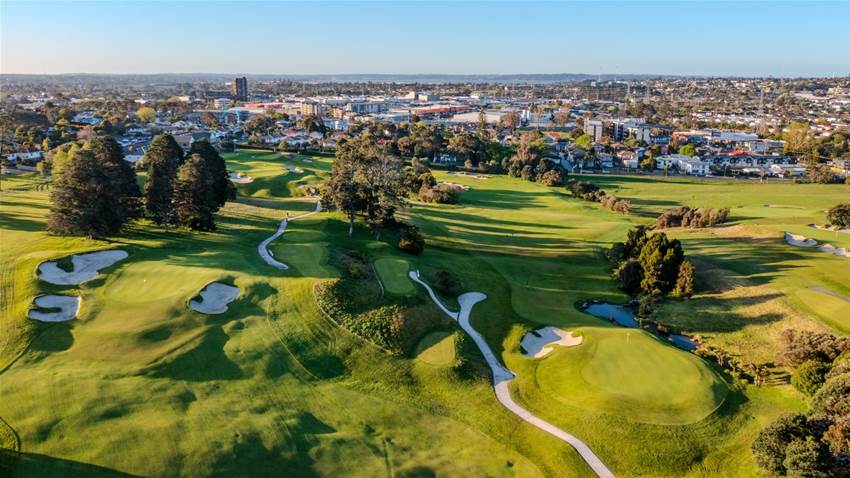The 1920s was a golden age for golf course construction in Australia thanks, in no small part, to the creativity and genius of legendary designer Dr Alister MacKenzie.
His trip to Australia in 1926, primarily to design Royal Melbourne’s West Course, ended with him designing or consulting on several courses including Kingston Heath, Victoria, Royal Adelaide and New South Wales Golf Clubs – all of which remain ranked among Australia’s top-10.
New Zealand also benefited from MacKenzie’s visit Down Under.
Having learned the “Good Doctor” was in Australia, the directors of Auckland’s then named Maungakiekie Golf Club – home to the Titirangi course – tracked MacKenzie down in Melbourne and sent a cablegram requesting he visit during a stopover on his voyage back to San Francisco. He accepted the invitation.
Although the club had been in existence since 1909, the idea to redesign the course had been proposed several years prior to MacKenzie’s arrival in Auckland on January 4, 1927.
He was confronted with a layout spread across a sometimes dramatically undulating landscape with several natural water hazards and pockets of native trees and shrubs. He stayed in Auckland for a month and oversaw the initial redesign work.
MacKenzie wrote of his visit: “…On the ‘Fringe of Heaven’ (better known in Māori as Titirangi) the ground was exceptionally well adapted for golf … it is undulating without being hilly and has many natural features such as ravines of a bold and impressive nature.”

MacKenzie spent days walking the property, making drawings, and advising the club’s committeemen in tow about his drastic “scheme”.
The New Zealand Herald of February 9, 1927, reported: “Dr MacKenzie’s proposal involves drastic changes, aiming at making the course more interesting.
“In his report, Dr MacKenzie recommended that the whole of the course should be kept cut, because golf was essentially a game for pleasure, and it was not right that players should spend half their time looking for balls.
“His scheme also provides for the bunkering of greens so that an erring shot would be punished. Only a straight shot would be able to reach the greens. “
Work began on MacKenzie’s design almost immediately and as was the case with his famous Royal Melbourne creation, he never saw his vision materialise and his Titirangi course officially opened for play on October 22, 1928, and immediately became the toast of New Zealand golf.
Exhibition matches at Titirangi became very popular during the 1930s and visiting golfers included legendary American players Walter Hagen and Gene Sarazen. In the 1950s, South African Bobby Locke was a regular visitor and often described Titirangi as New Zealand’s best course.
These exhibitions were a precursor to Titirangi’s golden years from the mid-1970s to the early 1990s as the club became New Zealand’s foremost tournament venue, hosting big events like the Air New Zealand-Shell Open, which attracted huge names like Arnold Palmer, David Graham, Billy Casper, Nick Faldo, Bernhard Langer, Sandy Lyle and Ian Baker-Finch.
Sadly, by 1996 the course had become rundown and overgrown in many parts. Much of the character Titirangi was famous for, and which had inspired MacKenzie, was lost.
Enter the frame English-born, New Zealand-based course architect Chris Pitman.

By the mid-1990s, Pitman was a 30-year devotee and student of MacKenzie’s work dating back to his time as an apprentice greenkeeper at West Herts in England.
Impressed by his knowledge of MacKenzie’s design principles, Titirangi’s directors commissioned Pitman to create a masterplan to return the layout to its former glory. Pitman did not change the routing, nor did he change any green sites. His major changes came in the form of modifying greens and bunkers as well as the removal of overgrown and old Pine trees that had encroached onto playing lines on many holes.
Using MacKenzie’s original sketches, Pitman embarked on an almost decade long redesign of Titirangi with outstanding results.
“Once appointed there was a unanimous decision that the layout and incorporation of the abundant natural features could not be bettered, certainly not by creating any monuments, so it was left well alone,” Pitman wrote after the course remodelling was completed.
“After all, the four par-3s were rated as good as any in the country and to my mind with a little modification and some developments in the grass roots department will always remain so. Boy, could Alister pick a greensite.
“As much a part of any MacKenzie challenge was surely to be the positioning and orientation of green sites. Patches of this prevailed as I began my acquaintance with the intricacies of the course.
“Putting surfaces set obliquely to the centrelines of play and high-faced bunkers placed sentinel-fashion to mask a certain amount of the green’s pin positions would realise the Doctor’s call for a constant installation of variety and subtlety. Of course, many memorable instances, in a far less subtle mode, came to be linked with the famous name.”
Titirangi opens with the easiest hole on the course, which is right out of the MacKenzie playbook and his theory that a golfer should be eased into a round. The 282-metre par 4 is a straightaway hole played over the crest of a hill and down to a green surrounded by a scheme of five bunkers. The flag might be blind from the tee, but this should not stop long hitters having a go at the green from the tee in the right conditions.
MacKenzie’s brilliance at finding unique and natural green sites are in evidence at the par-4 3rd and 6th holes where the dramatic terrain obviously excited the designer into taking full advantage of what Mother Nature was providing.
The 3rd – known as Cookes and named after Bert Cookes, who oversaw the construction of MacKenzie’s design – is the hardest two-shotter you will find on the layout and for good reason. A tough uphill tee shot is just the first challenge. The second is hitting a high-quality approach shot into a big green, protected by two bunkers, that lies just beyond a deep gully.

There are no gullies to deal with on the 387-metre par-4 6th hole, but, for mine, the challenge is equally tough. A blind tee shot awaits to a dogleg left fairway that tumbles gently downhill before veering left around the base of a hill and climbing towards the elevated green. The longer the drive here the harder the second shot becomes as you find yourself needing to hit a mid- or long-iron from a sidehill lie. For right-handers, this leaves the ball well below the feet and looking up at the green all you can see is a long, steep slope falling away from the right edge of the putting surface.
All four of Titirangi’s par-3s – long regarded among New Zealand’s best – were left virtually untouched by Pitman with only some bunker and greens modifications. The par-3s are so good the club puts up a ‘MacKenzie Award’ in certain competitions for any player who can par all four holes in their round.
In my opinion, the two back nine par-3s – the 11th and 14th holes – probably deserve higher acclaim than simply being among the best in NZ. This duo is world-class and as much fun to play as more famous one-shotters like the 7th at Pebble Beach, Royal Troon’s Postage Stamp or Tom’s Little Devil at Barnbougle Dunes.
The 161-metre 11th is known as Redan and was inspired by the 14th hole of the same name at North Berwick in Scotland. The green here is perched on a plateau beyond a valley and above the level of the tee. The putting surface sits diagonally to your approach, which must carry three large, deep bunkers short of the green, which slopes gradually from back left to front right.
The 187-metre 14th hole is a brilliant par-3 that you could never get bored of playing, even if you hit ball after ball into the fern and scrub-filled gully short and left of the heavily-bunkered green, There are, in fact, just three bunkers, short of the multi-tiered green but they are visually intimidating enough when you have a long iron or hybrid club in your hand. The 14th is a wonderful hole and adding to its beauty is the fact it has changed very little since MacKenzie sketched his vision for it almost a century ago.
Titirangi’s lasting impression is one of fun and excitement. This is not a long course but the variety of shots you must play across this wonderful golfing landscape will whet your appetite for more.
FACT FILE
LOCATION: Links Rd, New Lynn, Auckland, New Zealand.
CONTACT: +64 9 827 5749.
WEBSITE: www.titirangigolf.co.nz
DESIGNERS: Dr Alister MacKenzie (1928); Chris Pitman (2006); Clyde Johnson (2019).
NZ PGA PROFESSIONAL: Doug White.
PLAYING SURFACES: Poa annua (greens), mix of Brown Top, poa and couch (fairways).
COURSE SUPERINTENDENT: Greg Swafford.
GREEN FEES: NZ$275 (18 holes).
Related Articles

Course Review: Cape Kidnappers

Review: Omaha Beach Golf Club













